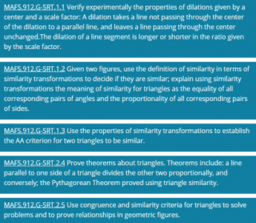Esquema
Similarity, Right Triangles, and Trigonometry (SRT) Cluster
MAFS.912.G-SRT.1.1 Verify experimentally the properties of dilations given by a center and a scale factor: A dilation takes a line not passing through the center of the dilation to a parallel line, and leaves a line passing through the center unchanged.The dilation of a line segment is longer or shorter in the ratio given by the scale factor.
MAFS.912.G-SRT.1.2 Given two figures, use the definition of similarity in terms of similarity transformations to decide if they are similar; explain using similarity transformations the meaning of similarity for triangles as the equality of all corresponding pairs of angles and the proportionality of all corresponding pairs of sides.
MAFS.912.G-SRT.1.3 Use the properties of similarity transformations to establish the AA criterion for two triangles to be similar.
MAFS.912.G-SRT.2.4 Prove theorems about triangles. Theorems include: a line parallel to one side of a triangle divides the other two proportionally, and conversely; the Pythagorean Theorem proved using triangle similarity.
MAFS.912.G-SRT.2.5 Use congruence and similarity criteria for triangles to solve problems and to prove relationships in geometric figures.
MAFS.912.G-SRT.3.6 Understand that by similarity, side ratios in right triangles are properties of the angles in the triangle, leading to definitions of trigonometric ratios for acute angles.
MAFS.912.G-SRT.3.7 Explain and use the relationship between the sine and cosine of complementary angles.
MAFS.912.G-SRT.3.8 Use trigonometric ratios and the Pythagorean Theorem to solve right triangles in applied problems.

Tabla de contenidos
MAFS.912.G-SRT.1.1
MAFS.912.G-SRT.1.2
MAFS.912.G-SRT.1.3
MAFS.912.G-SRT.2.4, 2.5
- SAS ~ Theorem
- SSS ~ Theorem (V1)
- Animation 63
- SSS ~ Theorem (V2)
- SSSS: Similar Quads?
- Similar Right Triangles (V1)
- Animation 13
- Pythagorean and similar triangles.
- Effortless Trisections
- Animation 134
- Parallel Lines Congruent Segments Theorem
- Parallel Lines Proportionality Theorem
- Triangle-Angle Bisector Theorem
- Animation 81
- Proof Without Words
- Wordless Pythagorean Theorem based on Translations
- Proof Without Words
- Proof Without Words
- Proof Without Words
- Proof Without Words
- Proof Without Words
- Proof Without Words
- Proof Without Words
- Proof Without Words
- Proof Without Words
MAFS.912.G-SRT.3.6, 3.7, 3.8
- Practice: Pythagorean Theorem (1)
- Quiz: Pythagorean Theorem (2B)
- Angles in Standard Position
- Animation 176
- Quiz: Evaluating Trigonometric Functions of Angles Given a Point on its Terminal Ray
- Evaluating Trig Functions Given a Point on the Terminal Ray
- Trig Ratio Possibilities (Hints)
- Right Triangle Trig: Solving for Sides (2)
- Quiz: Special Right Triangles
- Special Angles in Standard Position: Intro (V2)
- Special Angles in Standard Position: Intro (V3)
- Special Angles in Standard Position: Intro (V1)
- Animation 177
- Animation 178
- Right Triangle Trigonometry: Intro
- True Meaning of Sine, Cosine, Tangent Ratios within Right Triangles
- Trig Ratio Estimations (Quiz: V1)
- Trig Ratio Estimations (Quiz: V2)
- Trigonometric Ratios (Right Triangle Context)
- Discovering Sine, Cosine, and Tangent in Right Triangles
- What "CO" in COsine Means
- Quiz: Expressing Angles Using Inverse Trigonometric Function
- Animation 98
- Animation 99
- Animation 100
- YOUR Linear Speed?
- How Fast are You Spinning?